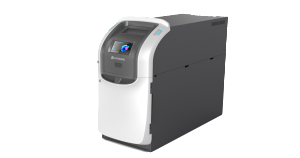Welcome to a new feature here on the Valuetec blog! We’ll be bringing you short, straight to the point posts on the equipment that you use every day, on the latest and greatest equipment upgrades, and whether or not they are applicable for your business. (If you like them or find them useful, please Share them with the links at the bottom.)
First up are Teller Cash Recyclers. They’ve been available for quite a few years now and are settling in to be an integral part of many operations. If you’ve been watching to see how they mature, or just have questions about them, here’s the 5 most important things to know:
- What type of cash-flow situation am I going to implement this in?
- What type of storage, note variety and capacity do I need?
- How will this unit be integrated to the core?
- How does this fit into any Branch Transformation plans?
- Will this affect my staffing costs? And how?
Part 1 of 4
How Does a Teller Cash Recycler Save Money and Improve Efficiency?
A teller cash recycler (or TCR) “lives” on your teller line. It is a miniature vault that handles both teller transactions and vault buy/sell transactions. Typically a TCR will sit between, and support, two tellers. In everyday usage, the TCR:
- accepts cash from tellers
- sorts bills by denomination
- checks for suspect counterfeits
- counts and verifies the total
- stores the notes for later dispensing or “recycling” .
A recycler also counts and dispenses cash as needed by its assigned tellers for client transactions such as check-cashing or withdrawals. It can be used by all other tellers for “vault buy” transactions.
Time is Money
When a recycler is chosen properly – more on this in Part 2– one of the immediate efficiency gains from a recycler is in cash counting time. Instead of a teller counting cash 3 times before giving to the customer, or both a teller and head teller counting cash 3 times for a vault transaction, the recycler counts and verifies as it dispenses or accepts. Typical dispense time for a teller cash-out transaction is around 8 seconds. Compare that to an estimated 45-60 seconds for a teller. If your teller has 60 cash clients per day, that’s an entire hour that customers stand there waiting, while your teller has their head down counting. What if your teller spent that hour talking to clients face-to-face, learning more about their upcoming financial needs? For commercial tellers sorting and counting those bigger deposits, the savings is even greater.
A less-apparent but important time gain is made by eliminating dual-person authentication. Vault transactions are estimated to take between 5-10 minutes each. A teller line with 4 tellers, averaging 3 vault transactions each, adds up to between 60 and 120 minutes’ time on a daily basis. How many more transactions could your tellers process in 1-2 hours per day? And is it helpful for your head teller to spend that time now performing more complex tasks?
We hope you’ve enjoyed learning a little about the TCR, along with a few insights into how it can increase your efficiency. If you have any questions, please call or email us and we’ll be happy to talk with you!
Part 1 – What is a Teller Cash Recycler? How can it save me money?
Part 2 – How does a Recycler compare to a Teller Cash Dispenser?
Part 3 – Technical considerations – how they store notes; and integrate into your core.



